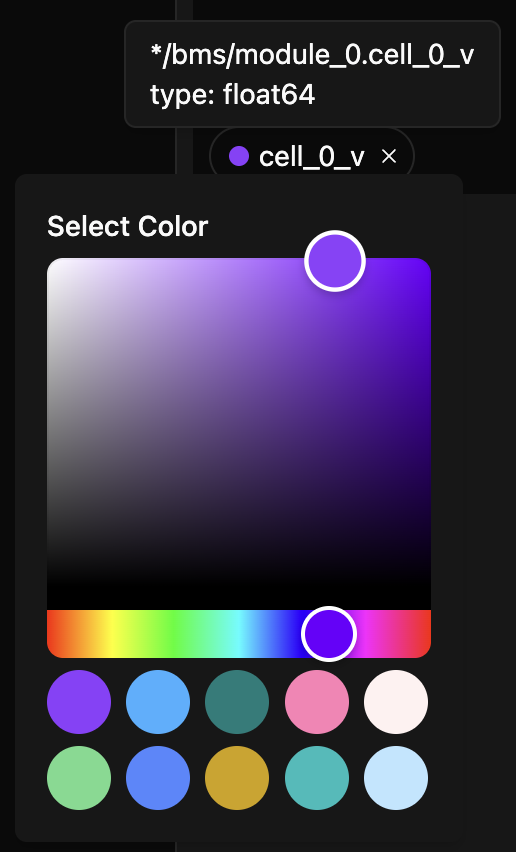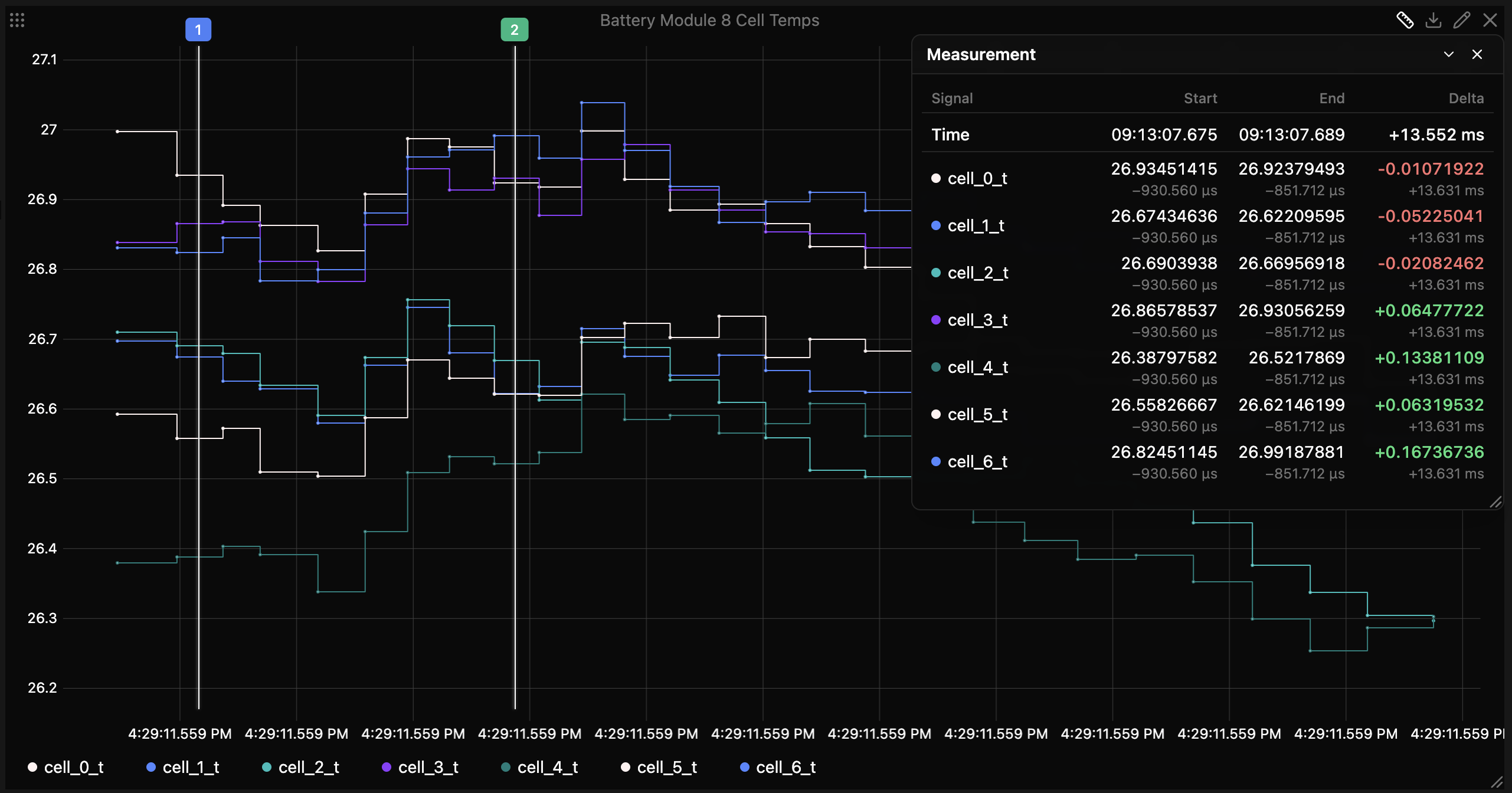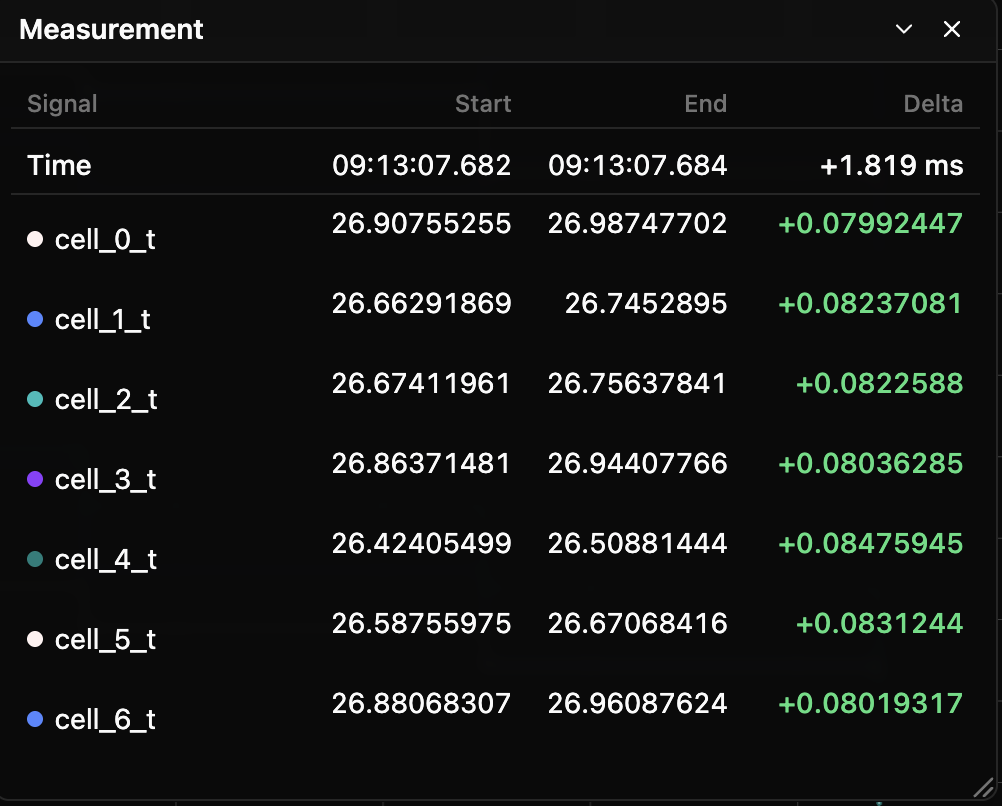Plot Panel¶
The Plot Panel visualizes your signal data as interactive time-series charts. It's designed for analyzing signal behavior over time with features like zooming, panning, and precise measurement capabilities.
Overview¶
The plot panel displays signals as line charts with time on the x-axis and signal values on the y-axis. Each signal gets its own color and can be toggled on/off individually. The panel supports real-time streaming data and historical analysis.
Basic Usage¶
Adding Signals¶
Drag and drop signals from the signal tree directly onto the plot panel. Each signal will appear as a colored line with a legend entry.
Navigation¶
- Click and drag to pan when zoomed in
- Double-click to toggle between live view and paused mode
Signal Management with Signal Chips¶
Below the plot, each signal is represented by an interactive signal chip that provides comprehensive signal management:
Color Management¶
- Color indicator - Colored circle showing the signal's current plot color
- Color picker - Click the color circle to open a color picker with preset palette and custom color selection
- Visual states - Solid circle when active, hollow circle when hidden
Signal Control¶
- Toggle visibility - Click anywhere on the chip to show/hide the signal line
- Remove signal - Click the X button to remove from the panel entirely
- Drag to other panels - Drag chips between panels to reorganize your data
Information Display¶
- Signal name - Shows full path or shortened name based on panel settings
- Data type - Hover to see signal data type in tooltip
- Status indicator - Grayed out when no data available for current time range

Measurement Tool¶
The measurement tool allows you to make precise measurements between two points on your signals. This is particularly useful for analyzing signal deltas, timing relationships, and precise value changes.
Activating Measurements¶
- Pause the view - The measurement tool is only available when not in live mode
- Click the ruler icon in the panel header to enable measurement mode
- Click on the plot to place your first cursor
- Click again to place your second cursor
- A measurement popup appears showing detailed results
Pause Required
The measurement tool is only available in paused mode. If you try to activate it while in live mode, you'll see a tooltip indicating you need to pause first.
Using Measurement Cursors¶
Once enabled, the measurement tool provides interactive cursors:
Cursor Placement¶
- Click anywhere on the plot to place cursors
- Cursors automatically snap to nearby data points for precision
- Cursor 1 (blue) must be placed before Cursor 2 (green)
- Cursors cannot cross each other
Moving Cursors¶
- Drag the cursor lines to reposition them
- Drag the numbered labels for easier cursor manipulation
- Cursors snap to actual data points

Measurement Results¶
The measurement popup displays comprehensive results for all visible signals:
Time Information¶
- Start Time - Timestamp of cursor 1 position
- End Time - Timestamp of cursor 2 position
- Delta - Time difference between cursors
Signal Measurements¶
For each visible signal, you'll see:
- Start Value - Signal value at cursor 1 position
- End Value - Signal value at cursor 2 position
- Delta - Value difference (End - Start)
Visible Signals Only
Measurements only include signals that are currently visible (not hidden via signal chips). Hidden signals won't appear in the measurement results.

Time Offset Indicators: When signal data points don't align exactly with cursor positions, small time offset indicators show the actual data timestamps. This ensures you know exactly which data points are being measured.
Managing the Results Popup¶
The measurement results popup is fully interactive:
You can:
- Drag the header to reposition anywhere on the panel
- Drag the resize handle (bottom-right corner) to adjust size
- Click the chevron to collapse/expand the popup
- Click the X button to clear both cursors and close the popup
Measurement Data Formats¶
Time Formatting¶
- Clock format (HH:MM:SS.mmm) for start/end times
- Delta format (+/-X.XXX s/ms/µs/ns) for time differences
- Automatic unit selection based on magnitude
Value Formatting¶
- Integer values displayed without decimals
- Decimal values limited to 8 decimal places
- Scientific notation preserved when present
- Enum values show both text and numeric representations
Precision¶
- All timestamps stored and calculated in nanosecond precision
- Values use the original signal precision
- Delta calculations account for actual data point timestamps
Plot Panel Settings¶
Access panel settings through the edit panel dialog:
Display Options¶
Panel Title: Set a custom title for the panel. Leave empty to use the default display.
Display Full Name:
Toggle between showing full signal paths (source/event.field) or shortened names (field).
Y-Axis Range¶
Control the Y-axis scale to focus on specific value ranges. Access these settings by clicking the edit button in the panel header.
By default, plots auto-scale to show all data. You can override this by setting min/max values:
| Min | Max | Behavior |
|---|---|---|
| Empty | Empty | Auto-scale to fit all data (default) |
0 |
Empty | Fixed bottom at 0, auto-scale top |
| Empty | 100 |
Auto-scale bottom, fixed top at 100 |
0 |
100 |
Fixed range from 0 to 100 |
Common Use Cases:
- Show zero baseline - Set Min=
0, leave Max empty - Logic level monitoring - Set Min=
0, Max=3.3for 3.3V signals - Zoom to range - Set both to focus on a specific value range
- Compare plots - Use identical ranges across multiple panels
Tip
Leave both fields empty to return to auto-scaling.
Tips¶
Measurement Accuracy¶
- Zoom in closer to your area of interest before placing cursors
- Use the snap-to-data-point feature for maximum precision
- Check time offset indicators when exact timing matters
- Hide irrelevant signals to focus measurements on signals of interest
Export Data¶
The plot panel supports exporting data in multiple formats:
- CSV - Tabular format with timestamps and signal values
- JSON - Structured format with metadata and arrays
Exported data respects the current time range and includes all visible signals. Measurement cursors do not affect export scope - the full visible time range is always exported.
Interaction Controls¶
- Double-click - Toggle between live and paused modes
- Scroll wheel - Zoom in/out on time axis
- Click and drag - Pan when zoomed in
Data Availability
Measurement accuracy depends on data resolution. Sparse data may result in measurements between data points rather than at exact cursor positions. Time offset indicators help identify these situations.